Industrial robots are increasingly vital in the manufacturing, pharmaceutical, and automation industries, driving the projected $9.31 billion revenue surge in the US industrial robotics market by 2024. However, with their popularity comes the need to address safety risks. This guide explores relevant safety standards for industrial robots and provides real-world examples of their application across diverse robotic systems. Keep reading or jump to a section to learn more!
Skip to a Section
Why Are Industrial Robot Safety Standards Important? | Types of Robot Safety Standards: | Different Types of Industrial Robots and Their Safety Measures: | Collaborative Robots (Cobots)
Why Are Industrial Robot Safety Standards Important?
![]() Robot safety standards are crucial for a variety of reasons. First and foremost, they prioritize the well-being of workers by safeguarding them against potential hazards posed by industrial robots. As these machines continue to advance and take on more complex tasks, it becomes essential to have safety measures in place to prevent accidents and injuries.
Robot safety standards are crucial for a variety of reasons. First and foremost, they prioritize the well-being of workers by safeguarding them against potential hazards posed by industrial robots. As these machines continue to advance and take on more complex tasks, it becomes essential to have safety measures in place to prevent accidents and injuries.
Moreover, adhering to robot safety standards can significantly enhance your business's overall efficiency and productivity. By implementing proper safety protocols, you can minimize downtime caused by accidents and ensure smooth operations. This helps avoid costly equipment repairs or replacements and fosters a secure and confident working environment for your employees.
Types of Robot Safety Standards:
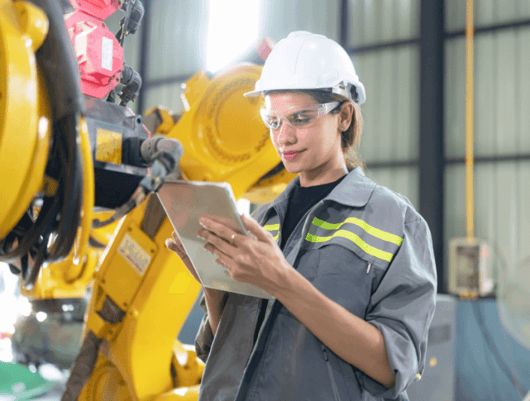
A Note on Robot Safety Standard Changes
While this guide provides an overview of different types of robot safety standards by the organizations below, it is essential to recognize that it is not exhaustive. The robotic industry is rapidly evolving, with new technologies and applications emerging regularly. Consequently, robotic safety requirements are continuously updated to keep pace with these advancements. Therefore, it is crucial to consult the specific safety standards relevant to your industry and location, as they may differ from those mentioned in this guide. The key is that ALL robot applications need a full risk assessment, no matter what type.
The American National Standards Institute (ANSI)

The American National Standards Institute (ANSI) plays a pivotal role in robot safety standards by providing and maintaining a framework that ensures workplace safety for people interacting with industrial robots. ANSI is a private, non-profit organization that oversees the creation, promulgation, and use of thousands of standards across an array of sectors, including the robotics industry.
Standards developed by ANSI, such as ANSI/RIA R15.06 for industrial robots and robot systems, establish guidelines for the design phase, safe integration, operation, and maintenance of robots, and protecting workers from potential hazards. By adhering to these standards, businesses can ensure safer work environments and remain compliant with industry regulations.
International Organization for Standardization (ISO)
.svg.png?width=100&height=92&name=ISO_Logo_(Red_square).svg.png)
The International Organization for Standardization, commonly known as ISO, is another influential body in the world of robot safety standards. This global entity develops and publishes international standards, including those for robotics. ISO 10218-1 and ISO 10218-2 are two key standards focused on robot safety.
ISO 10218-1 covers the manufacturing aspects of industrial robots, providing safety requirements for the design and integration of robots and robot systems. ISO 10218-2, on the other hand, provides safety guidelines for the installation and use of robots, including preventive measures for personnel working in close proximity to them.
These ISO standards aim to mitigate the risks in workplaces employing robots, and businesses that comply with these standards can improve safety and maintain a positive reputation in their respective industries. Conforming to ISO standards also fosters an environment of trust among customers, stakeholders, and employees, as they demonstrate a commitment to safety and quality.
European Norms (EN)

European Norms (EN) are another significant source of robot safety standards, especially for businesses operating within the European Union. These standards are developed by three European Standardization Organizations: CEN, CENELEC, and ETSI. For robotic safety, EN ISO 10218-1 and EN ISO 10218-2 are particularly relevant.
EN ISO 10218-1 addresses the manufacturer's requirements for the safe design and construction of robots. It ensures that any robot manufactured according to this standard maintains the highest safety level. Meanwhile, EN ISO 10218-2 is focused on the safe use and application of robots, including the integration and installation phases. It outlines all the necessary safety measures that need to be considered during the entire lifecycle of the industrial robot.
By complying with these EN standards, companies can ensure that they are meeting the highest safety regulations, which in turn can enhance their reputation and build trust among clients and employees alike. Importantly, adhering to these standards is a legal requirement for businesses operating within the European Union, thus they play a crucial role in maintaining safe and compliant operations.
Occupational Safety and Health Administration (OSHA)

The Occupational Safety and Health Administration (OSHA) is a U.S. government agency responsible for enforcing regulations and assuring safe and healthful working conditions for workers by setting and enforcing standards. OSHA's guidelines encompass a wide range of industries, including those involving robotics.
When it comes to industrial robot applications, OSHA doesn't have specific standards. However, they refer to and reinforce the required safety standards set by organizations like ANSI and ISO. For robotic safety, OSHA mainly refers to ANSI/RIA R15.06 for industrial robots and robot systems. OSHA plays a significant role in ensuring businesses adhere to these safety protocols by conducting inspections and audits, and they can impose penalties for violations.
It's worth noting that businesses can also take advantage of OSHA’s consultation program, a free guidance service that provides advice to small and medium-sized businesses in all states nationwide, with priority given to high-hazard worksites.
Adherence to OSHA regulations ensures regulatory compliance and significantly contributes to creating a safer working environment. By aligning with OSHA's recommendations and following ANSI and ISO standards, businesses can prioritize worker safety while enhancing productivity and operational efficiency.
.
Different Types of Industrial Robots and Their Safety Measures:
With a firm understanding of various industrial robot safety standards, we can now delve into their practical application across different robotic systems. The following section provides real-life examples illustrating how these safety standards come into play across a broad spectrum of robotic applications.
Note About Safety!
These robots possess inherent hazards and are typically hard-guarded. This is because they do not have built-in safety speeds and will not cease operation if they come into contact with a person. Safety mats, if utilized, are strictly employed for presence detection when the machine is not in use, preventing anyone from starting the machine while someone is in the vicinity. Enabling devices are only employed in situations where a predetermined slow speed is authorized, and only for a specified duration. For instance, they may be used for machine adjustment and maintenance purposes, limited to one minute, and accessible only to designated personnel. |
Articulated Robots
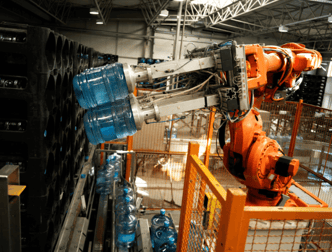
Articulated Robots are among the most common types of industrial robots. They have rotary joints ranging from two to ten or more joints. The arm is connected to the base with a twisting joint. This allows for a wide range of motion, making them suitable for tasks such as material handling, welding, painting, and much more.
Safety requirements for these robots likely include physical barriers, such as machine guarding or safety fences. These barriers separate robots from human workers, preventing accidental contact. In addition, light curtains can detect unauthorized access into the robot's work area. The light curtain usage is based on a stop-time analysis during a risk assessment.
Cartesian Robots
Cartesian robots, or gantry or linear robots, operate along an X, Y, and Z axis. They are typically used for pick and place work, sealant application, assembly operations, and handling machine tools. Examples include the Macron Dynamics and the Bosch Rexroth Mechatronic System Kit.
Safety measures for Cartesian robots often include pressure-sensitive safety mats that can detect the presence of workers in the robot's working area. If a worker steps on the mat, it triggers an immediate stop of the robot. Additionally, safety-rated monitored stops and speed & separation monitoring can regulate the robot's speed and halt operations if a human comes too close.
Delta Robots
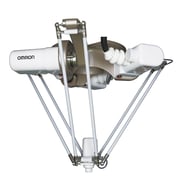 Delta robots are used for high-speed pick and place operations and are known for their high-speed and precision. They consist of parallel arms connected to universal joints. Examples include the Omron Quattro, Hornet & iX3, and the FANUC M-1iA.
Delta robots are used for high-speed pick and place operations and are known for their high-speed and precision. They consist of parallel arms connected to universal joints. Examples include the Omron Quattro, Hornet & iX3, and the FANUC M-1iA.
Safety measures for Delta robots may include two-hand control devices and enabling devices. Two-hand control devices require the operator to use both hands to control the robot, promoting a safer work environment by ensuring the operator's hands remain clear of the robot's workspace. Enabling devices allows workers to enter a robotic cell and halt robot movement if necessary based on the risk assessment.
SCARA Robots
SCARA (Selective Compliance Assembly Robot Arm) robots are typically used in high-speed assembly, packing, pick and place, and handling operations. They have two parallel joints providing compliance in one selected plane.
For safety, area scanners can monitor the designated work area of the robot, halting robot movement if a worker enters this designated space. An example is the Omron eCobra, i4L & i4H Series.
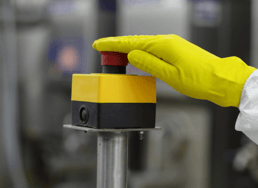
The above provides an overview of common safety solutions for industrial robots, but it's crucial to note that these are only general examples. The specific requirements for your robot application can vary significantly depending on the nature of your operations, the type of robots used, and the particular tasks they perform.
Therefore, it's highly recommended to undertake thorough safety risk assessments to identify all potential hazards and determine the correct safeguarding solutions accordingly. Regular safety risk assessments ensure compliance with regulations and contribute significantly to maintaining a safe and productive working environment.
Request a Safety Risk Assessment! Ask a question or contact an expert today. Our machine safety experts are here to help.
Collaborative Robots (Cobots)
Collaborative robots, commonly called cobots, represent a new chapter in the narrative of industrial robotics. Unlike traditional industrial robots, which typically operate in isolated environments, cobots are designed for human contact in shared workspaces. This human-robot collaboration brings with it a unique set of opportunities and challenges.
A common misconception is that collaborative robots, due to their inherent design to work with humans, arrive inherently safe. However, this is far from the truth. It is crucial to carefully consider the safety of collaborative robots and conduct a thorough risk assessment, as they pose potential risks similar to any industrial robot system. While cobots have safety features such as force limiting to prevent injuries during interaction, these safety measures might not be sufficient in every application.
Additional safety measures may need to be implemented to ensure collaborative robot safety. These can include safety-rated monitored stops, speed and separation monitoring, power and force limiting, and hand-guiding operations. Safety equipment such as safety light screens, laser scanners, or pressure-sensitive mats may also be required to ensure operator safety when working close to cobots.
The Omron TM robot can switch modes on the fly based on safety sensing. In collaborative mode, the robot moves much slower, and there are torque settings in the joints to prevent motion once contact is made. Utilizing collaborative robots still requires risk assessments due to the products they may be carrying. The TM robot has an internal zone set, so any contact with the head is a no-go.
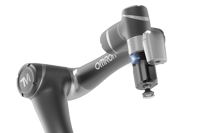 To learn more about collaborative robot safety and the necessary precautions, explore our comprehensive blog post that delves into this subject in greater detail. For an even more in-depth understanding, check out our on-demand webinar discussing safety measures for collaborative robots. Knowledge is power, and by understanding the safety requirements of collaborative robots, businesses can harness the power of human-robot collaboration while ensuring safe operation.
To learn more about collaborative robot safety and the necessary precautions, explore our comprehensive blog post that delves into this subject in greater detail. For an even more in-depth understanding, check out our on-demand webinar discussing safety measures for collaborative robots. Knowledge is power, and by understanding the safety requirements of collaborative robots, businesses can harness the power of human-robot collaboration while ensuring safe operation.
Industrial robot safety standards are absolutely essential for businesses that utilize robots. They play a critical role in minimizing risks, preventing accidents, and safeguarding workers. Conducting a risk assessment and adhering to these standards reduces downtime, boosts productivity, and ensures compliance.
For more guidance or to request a risk assessment, visit our safety website, www.mpsasafety.com. Our team of experts is ready to assist you in understanding and implementing the necessary safety standards for your business.
Sources:
- Statista
- 107815-ANSI/RIA-r1506-2012--the-industrial-robot-safety-standard
- Omron eCobra, i4L & i4H Series.





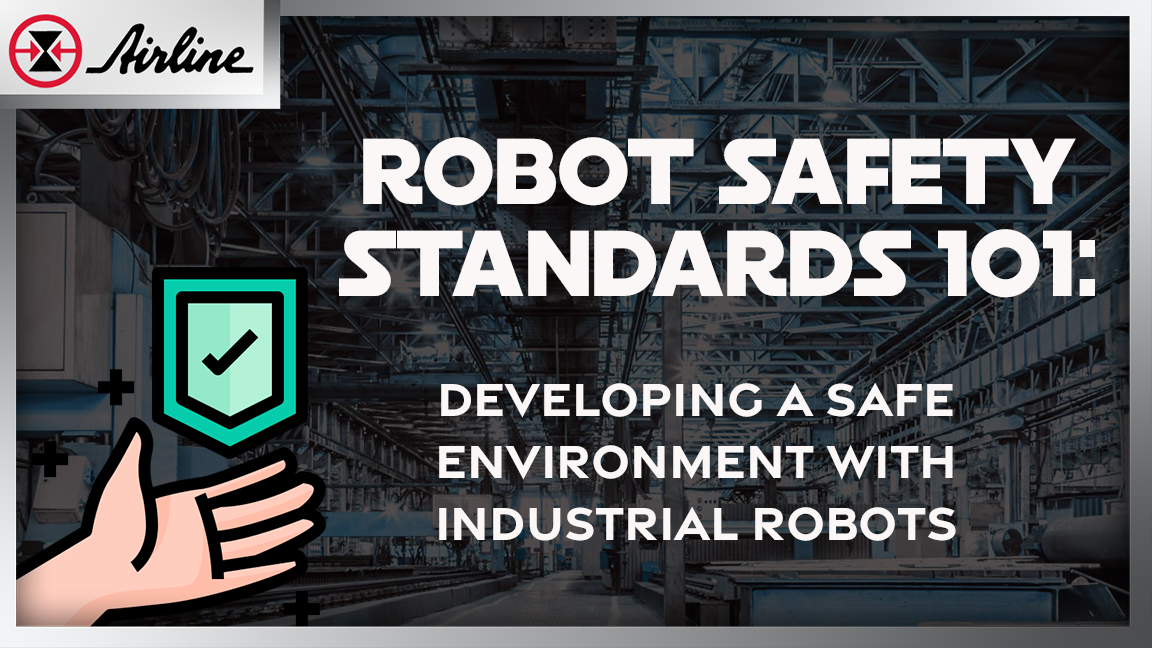

Leave Comment